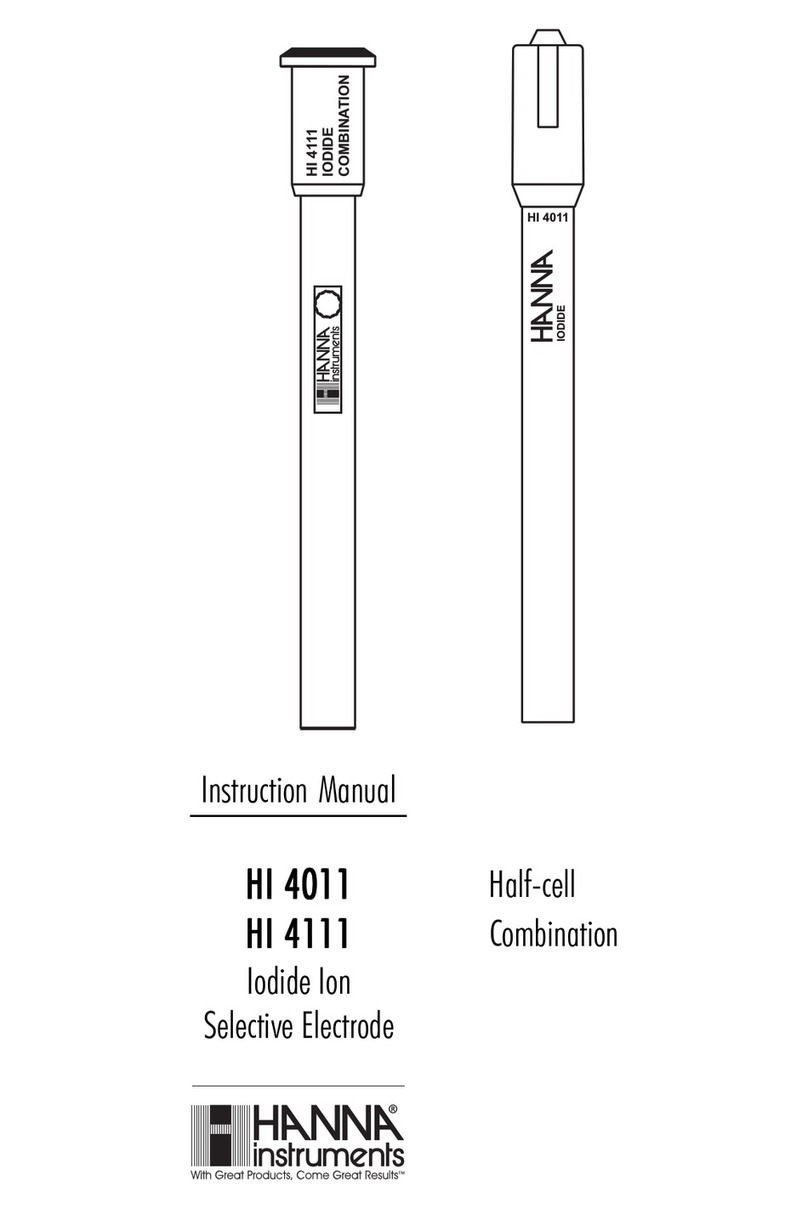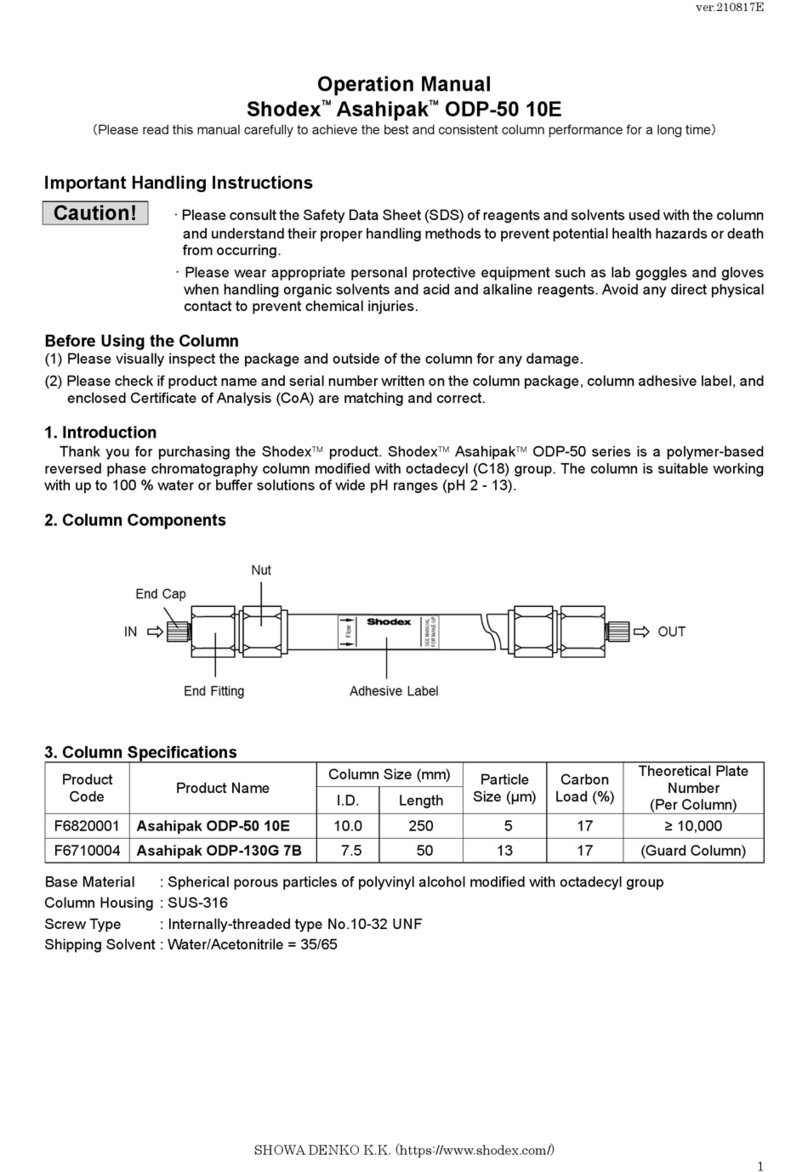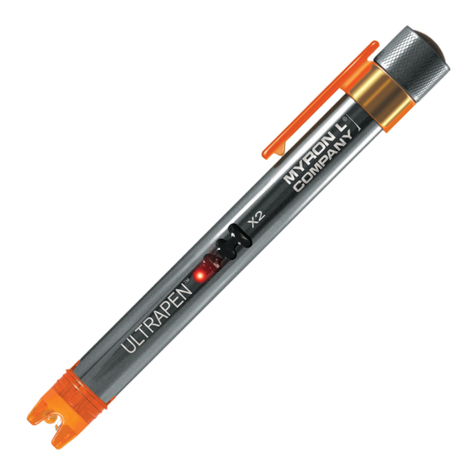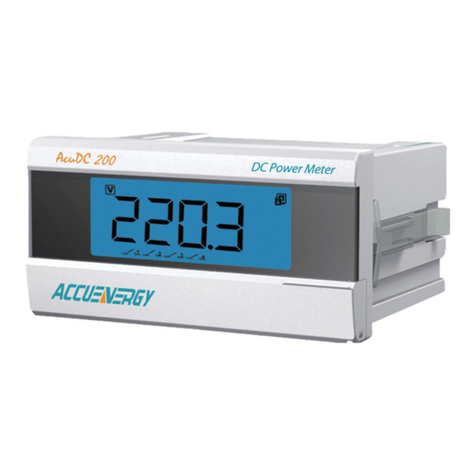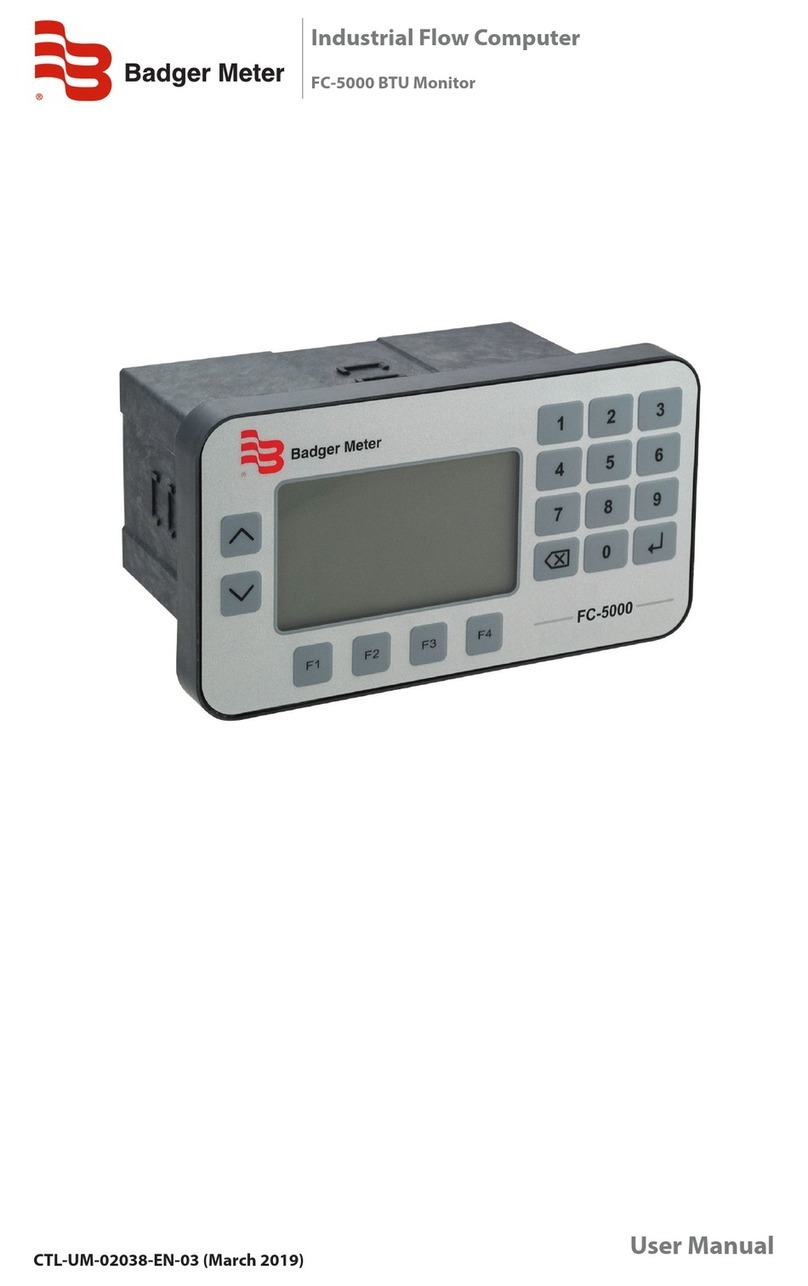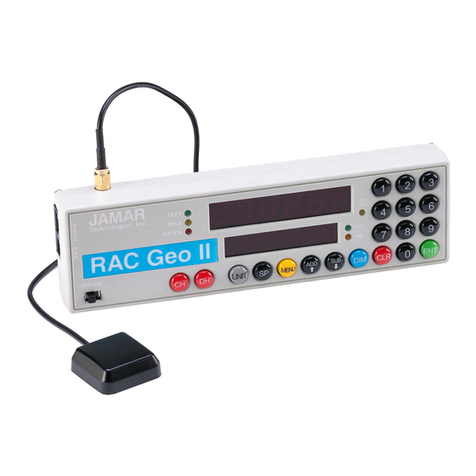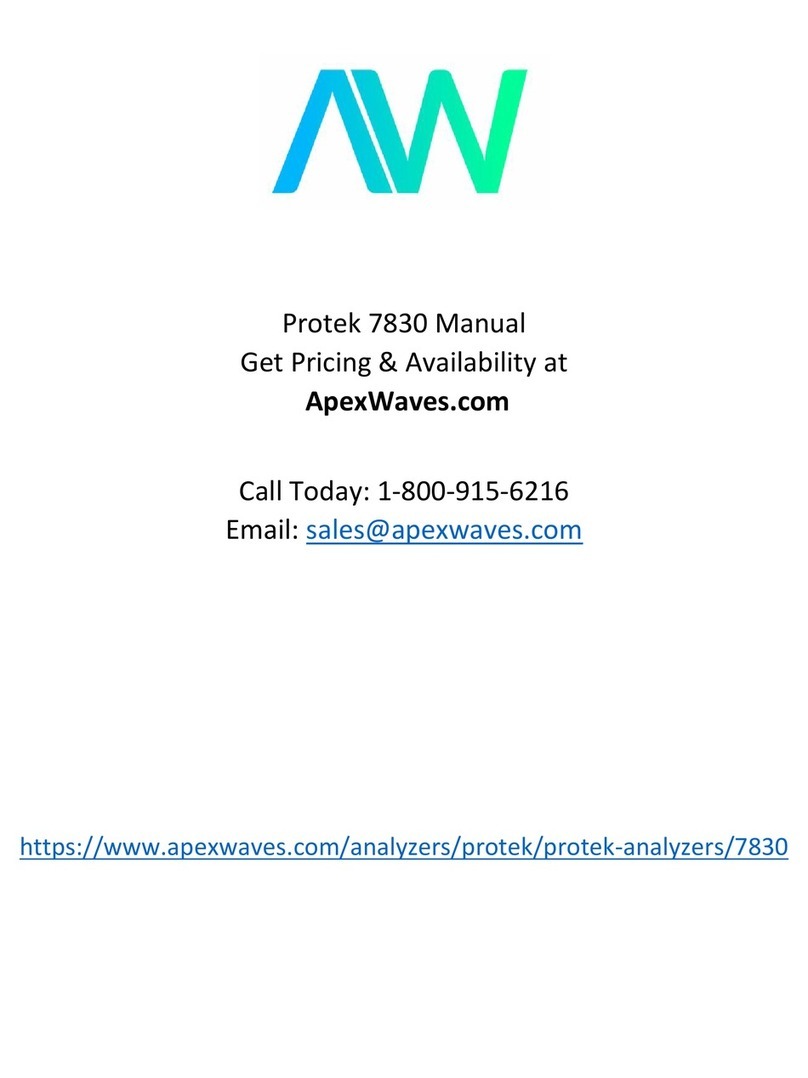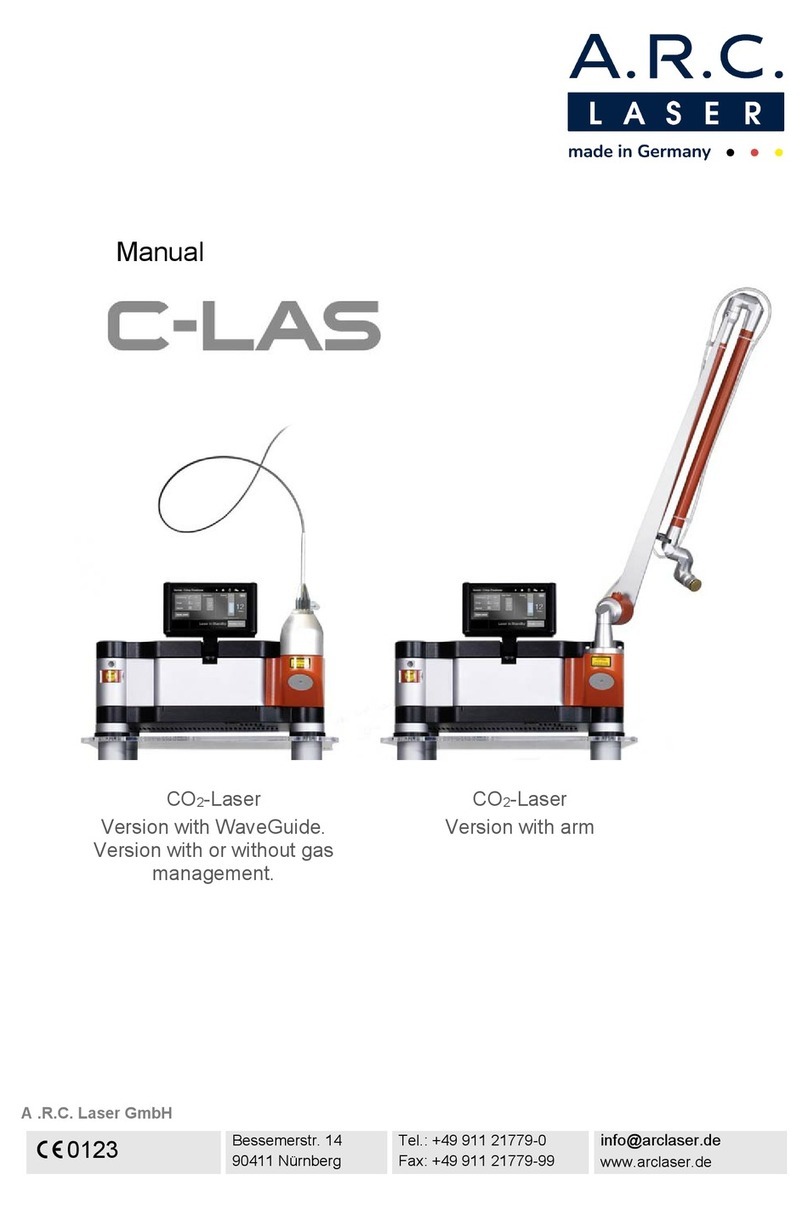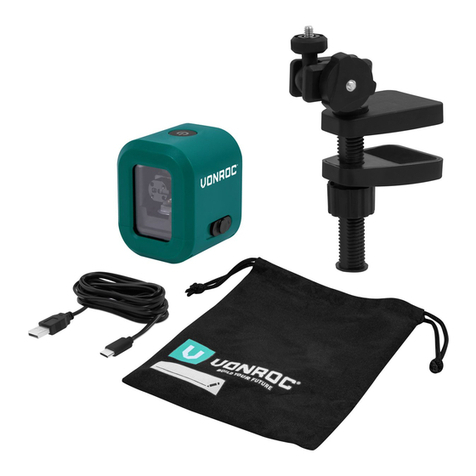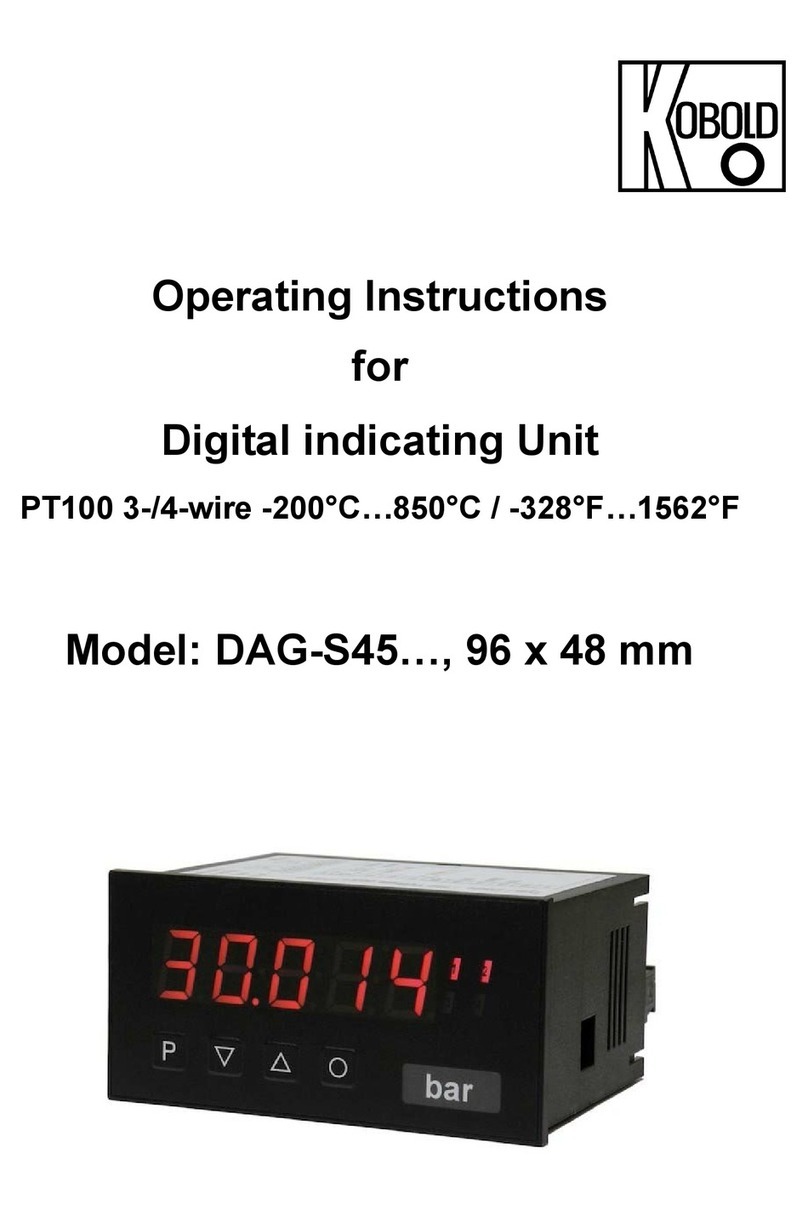Gonotec Osmomat Auto User manual

www.gonotec.com
User Guide
Osmolality Measurement in medical and pharmaceutical field
Cryoscopic Osmometer
OSMOMAT®auto

Notes, Safety Notices and Warnings
The symbols and abbreviations defined below may appear on the packing material, on the unit name
plate or in the operating instructions:
In-vitro diagnostic device
This product meets the requirements of
EEC Directive 98/79 relating to in-vitro
diagnostic devices.
Attention (refer to documentation)!
Please follow the safety notices of the user
guide.
“Use by …” The date that follows indicates
the expiration data as year-month.
Appears beside the name of the product
batch.
REF Item number or order number
The following pages provide a step-by-step introduction to using, maintaining and servicing the
measurement device. Passages requiring special attention are marked as follows:
This symbol warns of the danger of
corrupting measurement results, for
example, by improperly using measuring
vessels.
This symbol warns of the danger of
damaging the unit or the measurement
system, for example, as a result of improper
servicing.
)Note or tip.
Subject to errors and technical changes.
The information contained in this document may be changed without prior notice.
© 2006 Gonotec Gesellschaft für Meß- und Regeltechnik mbH. All rights reserved.
Reproduction of this document in any form is permissible only with the prior written consent of Gonotec Gesellschaft für Meß-
und Regeltechnik mbH.
The trademarks used in this document, GONOTEC, OSMOMAT and OSMOREF,are trademarks of
Gonotec Gesellschaft für Meß- und Regeltechnik mbH.
Other trademarks and trade names used in this document may be trademarks or names of the corresponding companies or
their products. Gonotec Gesellschaft für Meß- und Regeltechnik mbH does not assert any claim to trademarks or trade names
other than its own.
OSMOMAT®auto model, series 2005 and later
October 2009 Version 1.1

Contents
1Introduction....................................................................7
1.1 Applications of the OSMOMAT auto.............................................................................................. 7
1.1.1 Application Restrictions of the Osmomat auto............................................................................... 8
1.2 Measurement Method of the OSMOMAT auto.............................................................................. 8
1.3 Reproducibility in the OSMOMAT auto.......................................................................................... 8
1.4 Function of the OSMOMAT auto ................................................................................................... 9
1.5 Unpacking the Cryoscopic Osmometer OSMOMAT auto ........................................................... 10
1.6 Packaging Contents..................................................................................................................... 10
2Overview of the OSMOMAT auto ...............................11
2.1 Overview of Display and Connectors .......................................................................................... 11
2.2 Power Supply............................................................................................................................... 12
2.3 Dimensions and Weight............................................................................................................... 12
2.4 Sample Holder ............................................................................................................................. 13
3Setup and Initial Operation.........................................14
3.1 Safety and Handling Information ................................................................................................. 15
3.2 Known Risks Associated with the Use of the OSMOMAT auto .................................................. 15
4OSMOMAT auto Menu Structure................................16
4.1 Display and Keypad Overview..................................................................................................... 16
4.2 Menu Functions ........................................................................................................................... 17
5Calibration of the OSMOMAT auto.............................18
5.1 Calibration at Two Points............................................................................................................. 18
5.2 Calibration at Three Points .......................................................................................................... 19
6Measurement of a Sample Solution...........................21
6.1 Series Measurement.................................................................................................................... 23
7Print Functions ............................................................24
8Memory Management..................................................25
Contents | 3

Contents
9Error Messages and Troubleshooting.......................28
9.1 Spontaneous Crystallization ........................................................................................................ 28
9.2 Preventing False Readings Due to Spontaneous Crystallization.............................................. 28
9.3 Late or No Crystallization ............................................................................................................ 29
9.3.1 Excessive Osmolality................................................................................................................... 29
9.3.2 Injection with Ice Crystals Does Not Work................................................................................... 29
9.4 Classification of Malfunctions by Component Group................................................................... 30
10 Servicing of the OSMOMAT auto ...............................35
10.1 Requirements of the Medical Devices Operator Ordinance........................................................ 35
10.2 Safety Checks (§ 6 of Medical Devices Operator Ordinance)..................................................... 35
10.3 Measurement Checks (§ 11 of Medical Devices Operator Ordinance)..................................... 35
10.4 Internal Quality Control of the OSMOMAT auto .......................................................................... 35
10.5 Settings........................................................................................................................................ 36
10.6 Printer Maintenance..................................................................................................................... 39
10.7 Replacing the Cleaning Paper..................................................................................................... 40
10.8 Replacing a Defective Initiation Needle....................................................................................... 42
10.9 Replacing a Defective Power Fuse ............................................................................................. 43
10.10 Using the Correct Measuring Vessel........................................................................................... 44
■Intended Use ..................................................................................................................................... 44
■Specification ..................................................................................................................................... 44
■Forfeiture of the Measurement System Warranty .............................................................................. 44
11 Calibration Solutions for Osmometry........................45
11.1 GONOTEC Calibration and Reference Material.......................................................................... 45
Classification of the IVD ........................................................................................................................ 45
EC Conformity Declaration – Calibration and Reference Material........................................................ 45
Provisions of Certification...................................................................................................................... 45
11.2 Restrictions on the Use of the Calibration and Reference Materials........................................... 46
11.3 Composition................................................................................................................................. 46
11.4 Safety and Handling Information ................................................................................................. 46
11.5 Storage and Shelf Life ................................................................................................................. 47
11.6 Use of Other Calibration Solutions .............................................................................................. 47
4 | Contents

Contents
Appendix .................................................................................48
Consumables..........................................................................48
Accessories and Replacement Parts ...................................48
Classification of the IVD ........................................................................................................................ 49
EC Compliance Statement—OSMOMAT® auto.................................................................................... 49
Provisions of Certification...................................................................................................................... 49
Limited Warranty ....................................................................50
Returning Parts for Warranty ................................................51
Repair or Credit ......................................................................51
Before Calling Gonotec .........................................................51
Technical Data of the OSMOMAT auto.................................52
Remove of Transportation Lock ...........................................54
Contents | 5

Contents
List of Figures
Fig. 1 Freezing Point Depression of Solvent........................................................................................ 9
Fig. 2 Front view of the OSMOMAT auto ........................................................................................... 11
Fig. 3 Rear view of the OSMOMAT auto............................................................................................ 12
Fig. 4 Start sequence of the OSMOMAT auto.................................................................................... 14
Fig. 5 Keypad of the OSMOMAT auto................................................................................................ 16
Fig. 6 Incorrect feed direction for paper roll........................................................................................ 39
Fig. 7 Correct feed direction for paper roll.......................................................................................... 39
Fig. 8 Replacing the ribbon ................................................................................................................ 40
Fig. 9 Replacing a Initiation Needle.................................................................................................... 42
Fig. 10 Power switch ............................................................................................................................ 43
List of Tables
Table 1 Malfunction of the elevator track/lower cooling system/printer component group ................ 31
Table 2 Malfunction of the Upper Cooling System Component Group .............................................. 32
Table 3 Malfunction of EProm/thermistor probe component group ................................................... 33
Table 4 Malfunction of the Initiation Needle/Power Switch Component Group ................................. 34
Table 5 NaCl solutions for osmometry based on Geigy scientific tables, 8th edition ........................ 47
6 | Contents

1 Introduction
1 Introduction
1.1 Applications of the OSMOMAT auto
The Gonotec cryoscopic osmometer, Osmomat®auto, is a non-invasive in-vitro diagnostic device for
in-vitro analysis of human blood, urine, semen and other samples, such as drip solutions. Its purpose
is to provide information to help identify, diagnose, monitor and treat physiological conditions, states of
health, and illnesses.
The OSMOMAT®auto must be operated exclusively by persons whose training or skills have provided
them with the necessary practical experience (cf. German Medical Devices Operator Ordinance,
MPBetreibV).
The OSMOMAT auto is a fully automatic cryoscopic osmometer that is optimally suited for measuring
the total osmolality of aqueous solutions. It requires a sample volume of 50µl and up to 20 samples
can be measured and stored fully automatically in one procedure. Simple menu-controlled operation
helps to provide a high-performance and efficient measurement system for use in laboratories with
higher sample volumes.
The OSMOMAT auto is based on the proven measurement principle of the Osmomat 030.
The system developed by Gonotec for initiating crystallization by injecting ice crystals is also used
here.
The sample data can be entered via the keypad or a barcode reader prior to the measurement.
Measurement results are automatically assigned, stored in the unit (up to 300 samples), and can be
output immediately or later via the built-in standard paper printer by user command. Transfer to a PC
via the installed RS232 interface is possible.
Osmolality is an important measure of concentration for diluted solutions, such as all bodily fluids. In
the hospital or doctor’s office, osmolality can be used as one of several parameters to help form a
diagnosis or prompt further testing. In the pharmaceutical industry and research, the Osmomat auto is
used to test various aqueous solutions (saline drips, etc.) and for process validation.
The OSMOMAT auto has been applied successfully in the following fields:
General medicine Physiology Urology Veterinary
medicine
Routine and research Clinical laboratories Nephrology Pharmaceutics
Forensic medicine Intensive care laboratories Hemodialysis Pharmacies
Electron microscopy Pediatrics Hemofiltration … and many
more
Gynecology Botany
Introduction | 7

1 Introduction
1.1.1 Application Restrictions of the Osmomat auto
-The unit is not intended for determining the osmolality of dilutions.
-Only the osmolality of aqueous solutions can be determined.
Plausibility checks of the results must be performed by the doctor with the support of the pertinent
literature.
1.2 Measurement Method of the OSMOMAT auto
The OSMOMAT auto is a cryoscopic osmometer that measures the freezing point depression to
determine the total osmolality of aqueous solutions.
The freezing points of pure water and a solution are measured and compared. Whereas water has a
freezing point of 0°C, a solution with a saline concentration of 1 osmol/kg has a freezing point of
-1.858°C. That means that one mol of a given non-dissociated substance (6.023 x 1023 parts diluted in
one kilogram of water) lowers the freezing point of a solution by 1.858°C. The following definitions are
used in calculating osmolality:
Cosm = osmolality [osmol/kg]
T = freezing point depression [°C]
Cosm = ΔT / K
K = 1.858°C kg/osmol freezing point constant
The osmolality indicates the concentration of all osmotically active dissolved parts in the solvent.
Since the freezing point depression is directly proportional to the dissolved parts, the OSMOMAT auto
measures the osmolality directly.
1.3 Reproducibility in the OSMOMAT auto
Measurement
display LCD display, 4 lines with 20 characters
Measuring range 0 to approximately 2500 mOsmol/kg
Resolution 1 mOsmol /kg or 1 mOsmol/digit over the entire measuring range
Reproducibility
Sample volume 50µl #±1.0%
8 | Introduction

1 Introduction
1.4 Function of the OSMOMAT auto
The sample solution is cooled with a peltier cooling system while its temperature is electronically
monitored. Once the sample solution has reached a specific temperature below the freezing point,
crystallization is automatically initiated. The OSMOMAT auto initiates crystallization by injecting the
sample with a stainless steel needle that is cooled by a secondary upper cooling system and has
small ice crystals formed by moisture in the air on its tip. When crystallization begins, ice forms
spontaneously. The heat that was removed during undercooling is released again, the temperature
rises spontaneously, and the temperature of the sample rises to the freezing point.
If the sample consists of water (solvent), equilibrium is achieved as long as the sample contains water
and ice. The temperature remains constant because further heat removal does not result in a lowering
of the temperature but the formation of ice. The time of temperature equilibrium is known as plateau
time. Only after complete crystallization does the temperature fall again.
If the sample consists of a solution, the pure water in the solution crystallizes spontaneously and the
substances move to the rest of the solution. This means that at the time the freezing point temperature
is measured, the concentration is higher than in the original solution. A plateau occurs here as well,
but it is inclined. The osmolality reading is taken at the resulting reversal point (see Fig. 1). The
temperature is measured with a resolution of 1.858 x 10E-3°C.
Fig. 1 Freezing Point Depression of Solvent
Introduction | 9

1 Introduction
1.5 Unpacking the Cryoscopic Osmometer OSMOMAT auto
The cryoscopic osmometer OSMOMAT auto should be unpacked immediately upon receipt and
checked for obvious signs of damage sustained during shipping. If any damage is found, notify the
manufacturer:
Gonotec GmbH
GSG Hof Reuchlinstr. 10-11
Tel.: +49 (0)30 7809588-0
Fax: +49 (0)30 7809588-88
Web: www.gonotec.com
Germany
Toll-free service number within Germany: 0800 / 7846027
The packaging for this equipment was specially designed to ensure safe and hygienic transport. The
packaging is re-usable. Please save the packaging in case the unit needs to be shipped back to
Gonotec for repairs or servicing.
This will save you the time and money needed to find equally suitable packaging.
1.6 Packaging Contents
Check to make sure the contents of your shipment are complete. We cannot accept responsibility for
any missing items reported at a later date.
Accessories and consumables included in the shipment
Item number
OSMOMAT auto 20.9.0100 91 power cable
92 fine-wire fuses 230V 0.5A
((at 110V 1.0A)
00.9.0104
00.9.0106
35.9.0010 91000 measuring vessels
30.9.0020 9calibration standard 300 mOsmol/kg
35.9.0100 91 sample holder
30.2.0030 91 adjustment tool
30.9.0030 91 pasteur pipette (bellow)
30.9.1010 98 rolls of printer paper
35.9.1030 91 roll of cleaning paper
92 Allen wrenches (1.5 mm/2.5 mm)
91 user guide Osmomat auto
91 hand-held barcode scanner with power
supply
Barcode option 35.9.2000
10 | Introduction

2 Overview of the OSMOMAT auto
2 Overview of the OSMOMAT auto
2.1 Overview of Display and Connectors
LCD display
Keypad
Matrix printer
cover
Elevator with
Paper feed
Cleaning paper
holder
Lower front plate with
Transport fastener for
lower cooling system
Thermistor
Fig. 2 Front view of the OSMOMAT auto
Overview of the OSMOMAT auto | 11

2 Overview of the OSMOMAT auto
12 | Overview of the OSMOMAT auto
e holder for
tw -phase fuse
protection of the
voltage supply
Nameplate with serial no.,
voltage, frequency, and
power consumption
Pwr connection
Pwr switch
1/on 0/off
Fus
o
Serial output
Barcode reader
Serial output
RS232
Housing fan with
cover
1
0
FUSE
Potentiometer for
service settings
Fig. 3 Rear view of the OSMOMAT auto
2.2 Power Supply
The standard model is operated with 230V (+/- 20V) at 50/60Hz. The power consumption is 120VA.
Special models using 115V or 100V are also available.
2.3 Dimensions and Weight
Dimensions (width x depth x height): 275 x 225 x 390 mm
Weight: approximately 11.9 kg

2 Overview of the OSMOMAT auto
2.4 Sample Holder
■Components
- Sample stand
- Sample cover
- Sample holder
■Filling the Sample Holder
The sample holder can accommodate up to 20 samples. The sample spaces are numbered on the
sample holder from 1 through 20.
Position 0 is reserved for the initialization sample with distilled water. Refer to section 5 Calibration of
the OSMOMAT auto.
Initialization sample 20 sample spaces
The sample cover protects the samples from premature evaporation.
Observe the information in the following chapters Calibration of the OSMOMAT auto and
Measurement of a Sample Solution.
Overview of the OSMOMAT auto | 13

3 Setup and Initial Operation
3 Setup and Initial Operation
First, remove all transport protections as shown on the last page and store them for later servicing.
The unit must be placed in a location free from vibrations and must be protected from direct
sources of heat such as sunlight, heaters, or furnaces. The ambient temperature should be between
10°C and 30°C (50-95°F).
The air inlets and outlets on the bottom and back of the unit must be unobstructed. Use the provided
power cable to connect the OSMOMAT auto from the power connector on the back of the unit to a
power outlet. Make sure the unit’s ground is enabled via the shockproof grounding.
If the power cable plug does not match the conventional power outlets in your location, you may
substitute another power cable. It is essential, however, that the cable’s green/yellow wire be
connected to the safety grounding.
It is also important to ensure that the voltage indicated on the name plate matches that
of your electricity network. Incorrect voltage will cause the fuse in the power supply
unit to blow.
The OSMOMAT auto can now be switched on via the power switch on the back of the unit (next to the
power connector). Two system numbers, the system date and time, and an initialization text for the
warm-up phase are shown in quick succession (Fig. 4). The initialization text disappears after
approximately 3 minutes and a greeting is displayed. The OSMOMAT auto is ready for measurements
and the subsequent operations can now be selected via the menu.
The waiting period of approximately 3 minutes is necessary for the formation of ice crystals at the
upper cooling system.
The Esc key can be used to switch immediately to the menu but this does not affect the waiting period.
Fig. 4 Start sequence of the OSMOMAT auto
14 | Setup and Initial Operation

3 Setup and Initial Operation
3.1 Safety and Handling Information
The OSMOMAT auto cryoscopic osmometer is an electric laboratory measurement device. It should
therefore be handled according to the safety provisions and precautions for electric measurement,
control, and laboratory equipment.
The unit must be adequately disinfected prior to decommissioning. Equipment must be
decommissioned in accordance with local accident prevention guidelines.
The unit does not emit harmful substances either during operation or when switched off.
Symbols on the unit and its name plate correspond to the requirements of the following standards: DIN
EN 61010-1, DIN EN 375 and DIN EN 980 (harmonized standard for medical devices according to § 3
No. 17 of the German Medical Device Law MPG).
3.2 Known Risks Associated with the Use of the OSMOMAT auto
In our experience using the Osmomat auto, it has not been found to present any direct hazards or
risks to the user. Such hazards and risks cannot be excluded entirely for technical equipment,
however.
This user guide helps you gain a basic understanding of the design, the measurement principle,
maintenance and servicing of the unit. Please pay special attention to chapter 10.8, Replacing a
Defective Initiation Needle.
Setup and Initial Operation | 15

4 OSMOMAT auto Menu Structure
4 OSMOMAT auto Menu Structure
The menu shown on the display is operated via the arrow keys and number keys.
The individual menu points are selected via the arrow keys and the Esc key. The number keys and the
Ctrl key are used for data entry.
4.1 Display and Keypad Overview
S
election ke
y
s
Cleaning paper
feed
Select
print options
Printer paper
feed
O
p
eration LED
Print o
p
tions
10-digit keypad
with arrow keys
LCD display
Fig. 5 Keypad of the OSMOMAT auto
16 | OSMOMAT auto Menu Structure

4 OSMOMAT auto Menu Structure
4.2 Menu Functions
In the initial display, select measurements or settings and then the appropriate menu and submenu.
Select Continue to continue in the menu or OK to switch to the submenu. Press the Esc key to exit the
current menu level. Press the Esc key repeatedly to return from the submenu directly to the initial
display. The functions and option elements are described in the individual chapters.
■Measurements and Settings
Select > sample to perform sample measurements, calibrate the unit, and manage the sample data.
Select >adjust to change basic settings, such as the date and time and the cleaning paper feed, and
to conduct maintenance work, such as testing the initiation function, newly initializing the unit, and
adjusting the thermistor probe.
OSMOMAT auto Menu Structure | 17

5 Calibration of the OSMOMAT auto
5 Calibration of the OSMOMAT auto
Before the total osmolality of sample solutions can be measured, the OSMOMAT auto must be
calibrated with distilled water and a calibration standard.
5.1 Calibration at Two Points
Two clean, dry measuring vessels are first filled via a pipette with 50 µl distilled water and 50 µl
Gonotec calibration standard 300 mOsmol/kg. In this process
there must be no visible air bubbles in the liquid!
The sample holder is numbered 0 through 20 from left to right. The sample holder is to be filled as
follows:
Positions 0and 1with distilled water
Positions 2 and 3 with 300 mOsmol/kg
Use the proper sequence when filling the sample holder. Incorrect placement results in
incorrect calibration!
The sample cover is then placed on the sample holder to prevent premature evaporation of the
samples.
The sample cover reduces the risk of premature evaporation of the samples. However,
it does not protect the samples from leakage.
To perform the calibration, select > sample > calibration in the initial display. Select > number of calib-
samples > 2in the display to calibrate at two points. Use choose,to select the calibration value of the
calibration standard to be used > 100 200 300 500 600 700 850 900 1200 1500 1800 2000 2500. The
value for the distilled water is predefined at 0 mOsmol/kg. Confirm your selection with OK. The
following display > sample sequence again shows your calibration settings and the corresponding
positions of the solutions in the sample holder – e.g. 0 0 0.300 0.300 for a calibration at two points with
distilled water and Gonotec calibration standard 300 mOsmol/kg. Select OK to accept the settings.
With Cancel you can discard the settings and return to the display > calibration.
18 | Calibration of the OSMOMAT auto

5 Calibration of the OSMOMAT auto
You will now be prompted to insert the sample holder in the unit. The Osmomat auto automatically
detects the inserted sample holder and begins the calibration.
The calibration values are now consecutively shown on the display. If the printer is switched on, these
values are also printed. After successful calibration, the message > accept calibrationmeas.? appears.
Confirm the calibration values with OK. The unit then automatically prepares for sample measurement.
Otherwise select repeat to discard the calibration values and recalibrate the unit.
)Note: A 2P or 3P is displayed on the right side of the initial display and the displays of the
submenu. These signalize the calibration status of the unit. A 2P indicates two-point
calibration and a 3P indicates three-point calibration. The status changes according to
the calibration performed. This status is retained even after the unit is switched off and
restarted but lost after new initialization.
)Note: Prior to the calibration procedure, switch the printer on to document the calibration
results. Subsequent display or printing is not possible!
5.2 Calibration at Three Points
Two clean, dry measuring vessels are first filled via a pipette with 50 µl distilled water, 50 µl Gonotec
calibration standard 300 mOsmol/kg, and 50 µl 850 mOsmol/kg.
There must be no visible air bubbles in the liquid!
The sample holder is numbered 0 through 20 from left to right. The sample holder is to be filled as
follows:
Positions 0and 1with distilled water
Positions 2 and 3 with 300 mOsmol/kg
Positions 4 and 5 with 850 mOsmol/kg
Use the proper sequence when filling the sample holder. Incorrect placement results in
incorrect calibration!
The sample cover is then placed on the sample holder to prevent premature evaporation of the
samples.
The sample cover reduces the risk of premature evaporation of the samples. However,
it does not protect the samples from leakage.
Calibration of the OSMOMAT auto | 19

5 Calibration of the OSMOMAT auto
To perform the calibration, select > sample > calibration in the initial display. Select > number of calib-
samples > 3in the display to calibrate at three points. The value for distilled water is predefined at 0
mOsmol/kg.
Selection of a first calibration point (c1): With choose,select the calibration value of the
calibration standard to be used for the first calibration point > 100 200 300 500 600 700 850 900
1200 1500 1800 2000 2500. Confirm your selection with OK.The system automatically specifies
the first possible second calibration point.
Selection of a second calibration point (c2): Use choose, to change the defined calibration
value to the calibration standard to be used for the second calibration point. Confirm your selection
with OK.
)Note: The following applies for 'c2': the minimum distance from c1 is the calibration point
after next. For example:
If 'c1' = 100 mOsmol/kg, all calibration points above 300 mOsmol/kg are possible for 'c2'.
If 'c1' = 200 mOsmol/kg, all calibration points above 500 mOsmol/kg are possible for 'c2'.
If 'c1' = 300 mOsmol/kg, all calibration points above 600 mOsmol/kg are possible for 'c2'.
…
If 'c1' = 2000 mOsmol/kg, 3000 mOsmol/kg are possible for 'c2'.
The following display > sample sequence shows 0 0 c1c1 c2c2, the sequence for placing the distilled
water (0), the first calibration standard (c1), and the second calibration standard (c2) in the sample
holder. Select OK to accept the settings. With Cancel you can discard the settings and return to the >
calibration display.
You will now be prompted to insert the sample holder in the unit.
The Osmomat auto automatically detects the inserted sample holder and begins the calibration.
The calibration values are now shown consecutively on the display. If the printer is switched on, these
values are also printed. After successful calibration, the message > accept calibrationmeas.? appears.
Confirm the calibration values with OK. The unit then automatically prepares for sample measurement.
Otherwise select repeat to discard the calibration values and recalibrate the unit.
)Note: Prior to the calibration procedure, switch the printer on to document the calibration
results. Subsequent display or printing is not possible!
20 | Calibration of the OSMOMAT auto
Table of contents
Popular Measuring Instrument manuals by other brands

Wohler
Wohler IQ 300 operating manual
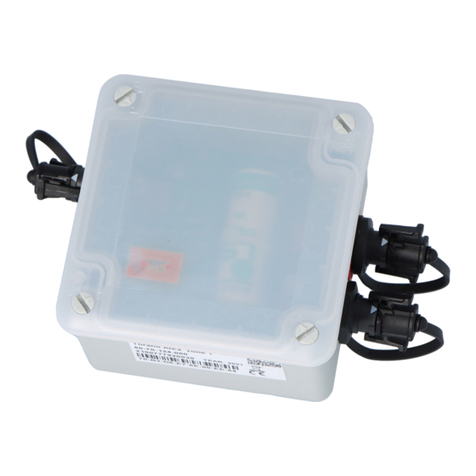
WATTECO
WATTECO Toran'O Atex zone 1 50-70-124 quick start guide

Leuze electronic
Leuze electronic AMS 301i manual
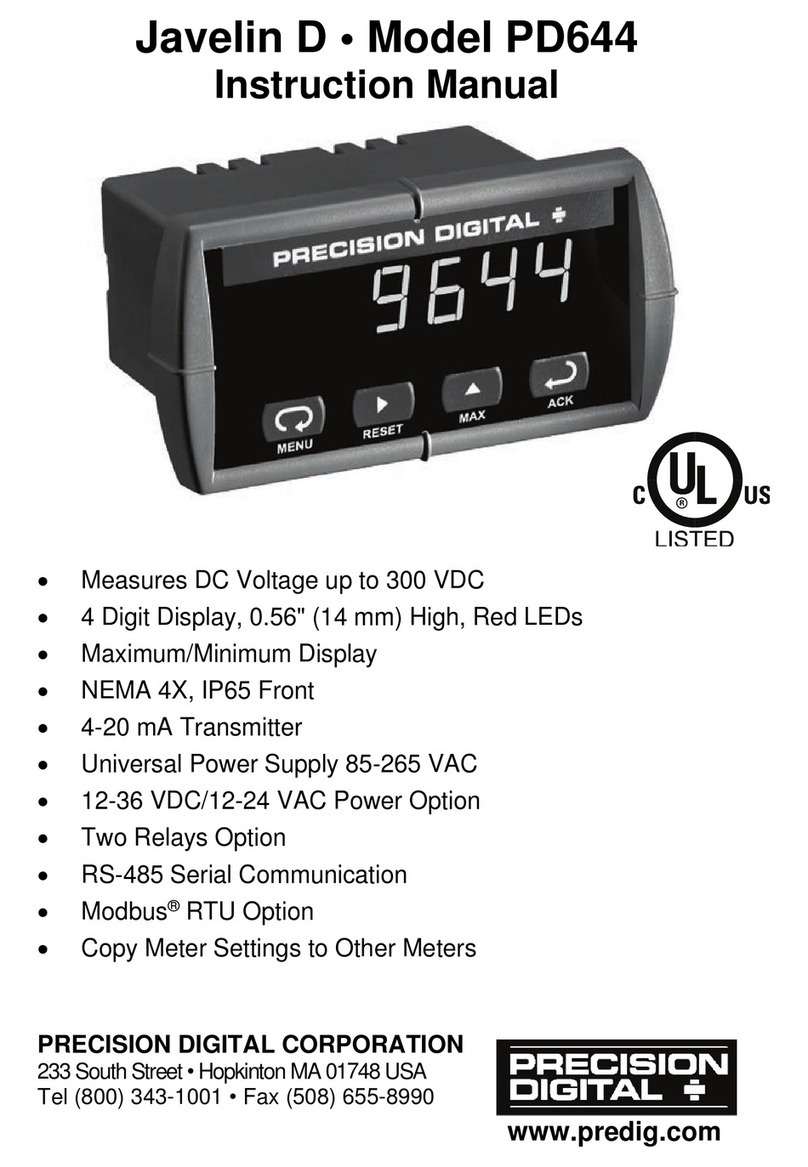
PRECISION DIGITAL
PRECISION DIGITAL Javelin D PD644 instruction manual

Honeywell
Honeywell GENT S4-34 Series Data and Installation
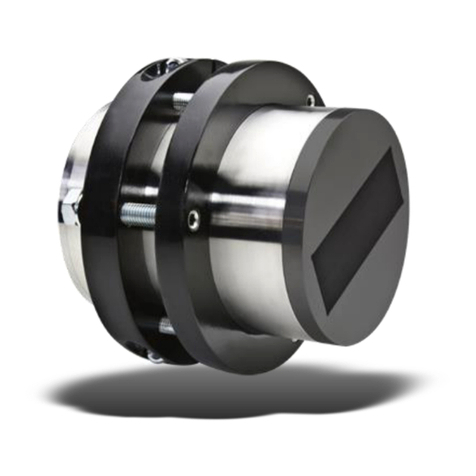
IMKO
IMKO SONO-MIX Standard user manual
